
Triteleia is a genus of monocotyledon flowering plants also known as triplet lilies. Species are native to western North America, from British Columbia south to California, with one species in northwestern Mexico. However they are most common in California. They are perennial plants growing from a fibrous corm, roughly spherical in shape. They get their name from the fact that all parts of their flowers come in threes.
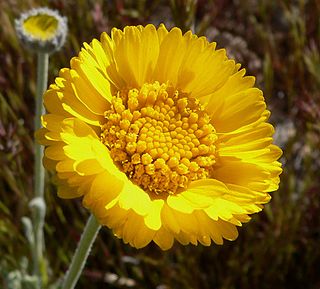
Baileya is a genus of plants in the aster family Asteraceae. All are native to the southwestern United States and to Mexico.

Coastal sage scrub, also known as coastal scrub, CSS, or soft chaparral, is a low scrubland plant community of the California coastal sage and chaparral subecoregion, found in coastal California and northwestern coastal Baja California. It is within the California chaparral and woodlands ecoregion, of the Mediterranean forests, woodlands, and scrub biome.

Agastache is a genus of aromatic flowering herbaceous perennial plants in the family Lamiaceae. It contains 22 species, mainly native to North America, one species native to eastern Asia. The common names of the species are a variety of fairly ambiguous and confusing "hyssops" and "mints"; as a whole the genus is known as giant hyssops or hummingbird mints.
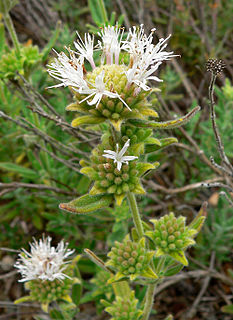
Monardella is a genus of approximately 40 species of annual and perennial plants native to western North America from British Columbia to northwestern Mexico. They are grown for their highly aromatic foliage, which in some species is used for herbal teas. The two-lipped, tubular flowers are formed in terminal clusters and are most usually red, pink, or purple.

Stephanomeria is a genus of North American plants also known as wirelettuce, belonging to the dandelion tribe within the sunflower family.

Acanthomintha is a genus of the mint family, Lamiaceae. The genus Acanthomintha is commonly referred to as thornmint or thorn-mint. There are four species within this genus, including the endangered species Acanthomintha duttonii. All four thornmints are native to the California Floristic Province. The origin of the genus name is from the identical Greek word meaning thornmint.
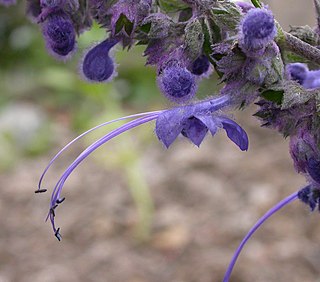
Trichostema is a genus of flowering plants in the family Lamiaceae, which are aromatic herbs or subshrubs. These plants are native to North America. Many plant of this genus which have whorls of small blue flowers are called by the common name bluecurls.

Lepechinia is a genus of plants in the mint family, Lamiaceae. It includes several species of plants known commonly as pitchersages. Plants of this genus can be found in Central and South America, Mexico, California, Hispaniola, and Hawaii, although the species in Hawaii is probably a human introduction. Many of them bear attractive pitcher-shaped flowers, often in shades of purple. The genus was named for the Russian botanist Ivan Ivanovich Lepechin. Recently, the two monotypic genera Chaunostoma and Neoeplingia were shown to be part of Lepechinia.
- Lepechinia anomalaEpling - southern Brazil
- Lepechinia bellaEpling - Bolivia
- Lepechinia betonicaefolia(Lam.) Epling - Colombia, Ecuador
- Lepechinia bullata (Kunth) Epling - Colombia, Ecuador, Venezuela
- Lepechinia calycina(Benth.) Epling ex Munz – pitcher sage, woodbalm - California
- Lepechinia cardiophyllaEpling – Santa Ana pitcher sage - southern California, Baja California
- Lepechinia caulescens(Ortega) Epling - Mexico, Guatemala
- Lepechinia chamaedryoides(Balb.) Epling - Chile
- Lepechinia cocuyensisJ.R.I.Wood - Colombia
- Lepechinia codonEpling - Peru
- Lepechinia conferta(Benth.) Epling - Colombia, Venezuela
- Lepechinia dioicaJ.A.Hart - Ecuador
- Lepechinia flammeaMart.Gord. & Lozada-Pérez - Guerrero
- Lepechinia floribunda(Benth.) Epling - Peru, Bolivia, Argentina
- Lepechinia fragrans(Greene) Epling – island pitcher sage, fragrant pitcher sage - southern California including offshore Channel Islands
- Lepechinia ganderiEpling – San Diego pitcher sage - southern California, Baja California
- Lepechinia glomerataEpling - Jalisco
- Lepechinia hastata(A.Gray) Epling – pakata - Baja California and Baja California Sur, including Revillagigedo Islands; naturalized in Hawaii
- Lepechinia heteromorpha (Briq.) Epling - Ecuador, Peru, Bolivia
- Lepechinia lamiifolia(Benth.) Epling - Ecuador, Peru
- Lepechinia lancifolia(Rusby) Epling - Bolivia
- Lepechinia leucophylloides(Ramamoorthy, Hiriart & Medrano) B.T.Drew, Cacho & Sytsma - Hidalgo
- Lepechinia maricaEpling & Mathias - Peru
- Lepechinia mecistandra(Donn.Sm.) H.K.Moon - Chiapas, Guatemala, El Salvador
- Lepechinia mexicana(S.Schauer) Epling - central + northeastern Mexico
- Lepechinia meyenii(Walp.) Epling - Peru, Bolivia, Argentina
- Lepechinia mollis(Epling) Epling - Peru
- Lepechinia mutica(Benth.) Epling - Ecuador
- Lepechinia nelsonii(Fernald) Epling - central + southern Mexico
- Lepechinia paniculata(Kunth) Epling - Ecuador
- Lepechinia radula (Benth.) Epling - Ecuador, Peru
- Lepechinia rossiiS.Boyd & Mistretta – Ross' pitcher sage - southern California
- Lepechinia rufocampiiEpling & Mathias - Ecuador
- Lepechinia salviae(Lindl.) Epling - Chile
- Lepechinia salviifolia(Kunth) Epling - Colombia, Venezuela
- Lepechinia schiedeana(Schltdl.) Vatke - Mexico, Guatemala, Costa Rica, Panama, Colombia, Venezuela
- Lepechinia scobinaEpling - Peru
- Lepechinia speciosa(A.St.-Hil. ex Benth.) Epling - southern Brazil
- Lepechinia tomentosa(Benth.) Epling - Peru
- Lepechinia urbani (Briq.) Epling - Hispaniola
- Lepechinia velutinaJ.R.I.Wood - Colombia
- Lepechinia vesiculosa(Benth.) Epling - Peru, Bolivia, Argentina
- Lepechinia vulcanicolaJ.R.I.Wood - Colombia
- Lepechinia yecoranaHenrickson, Fishbein & T.Van Devender - Sonora

Githopsis is a small genus of flowering plants in the bellflower family which are known as bluecups. These are small annual wildflowers with white or purple white-throated blooms. Bluecups are native to western North America, especially California. There are four known species within the genus.

Hulsea is a small genus of North American flowering plants in the sunflower family known commonly as alpinegold.
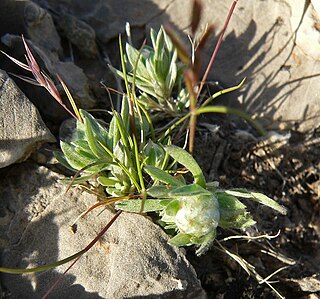
Stylocline(neststraw) is a small genus of North American desert plants in the Inuleae tribe within the daisy family.
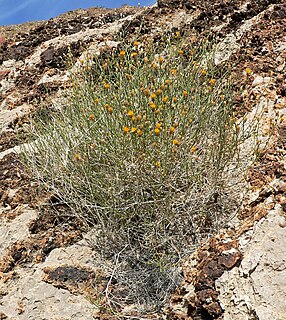
Bebbia, common name sweetbush, is a genus of aromatic shrubs in the daisy family.

Dudleya abramsii is a succulent plant known by the common name Abrams' liveforever. The epithet abramsii commemorates LeRoy Abrams. It is native to California and northern Baja California, where it grows in rocky areas in a number of habitat types. It is a fleshy perennial forming a small basal cluster of leaves around a central caudex. The thick, waxy leaves are triangular to oblong and usually pointed, reaching up to 11 centimeters in length, but often remaining much smaller. The entire rosette is generally only a few centimeters wide. The inflorescence is a mostly erect, branching stem lined with pointed bracts and bearing up to 15 flowers. The flower has five small, thick sepals at the base of five pale yellow petals each about a centimeter long.

Nemacladus is a genus of flowering plants in the bellflower family known generally as threadplants. There are 18 accepted species native to the southwestern United States and northern Mexico. These are annual herbs with very slender, sometimes threadlike, branching stems bearing small five-lobed flowers.
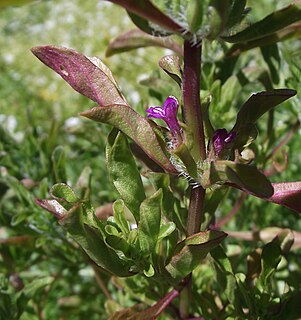
Pogogyne douglasii is a species of flowering plant in the mint family known by the common names Douglas' mesamint and Douglas' beardstyle.
Pogogyne floribunda is a species of flowering plant in the mint family known by the common names profuseflower mesamint and profuse-flowered pogogyne. It is native to the Modoc Plateau and surrounding basin habitat in the northeastern corner of California. It is known from six occurrences in adjacent Oregon and one in Idaho. It can be found in vernal pools, ephemeral creeks, and other summer-dry water bodies on the plateau. This is an aromatic annual herb producing a mostly erect, branching stem which is lined nearly from base to top with inflorescence. The lipped, tubular flowers are about half a centimeter long and white in color. Most have purple spots or red speckles, while a few are pure white or solid pale purple. Each is surrounded by a calyx of pointed sepals which are coated in long white hairs.
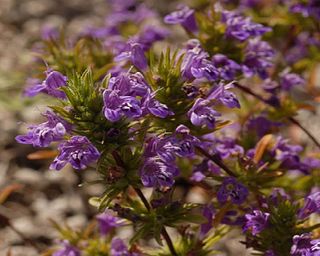
Pogogyne nudiuscula is a rare species of flowering plant in the mint family known by the common name Otay mesa mint. It is native to southern San Diego County, California, where it is known only from Otay Mesa near the border with Baja California. It was identified on land south of the Mexican border, but these occurrences have probably been extirpated. It is now known from seven vernal pool complexes just north of the border, and it is a federally listed endangered species of the United States.
Pogogyne zizyphoroides is a species of flowering plant in the mint family known by the common names Sacramento mesamint and Sacramento beardstyle.






















